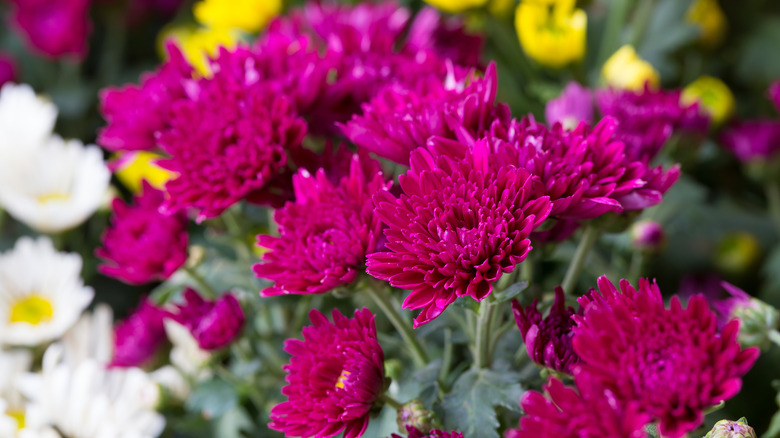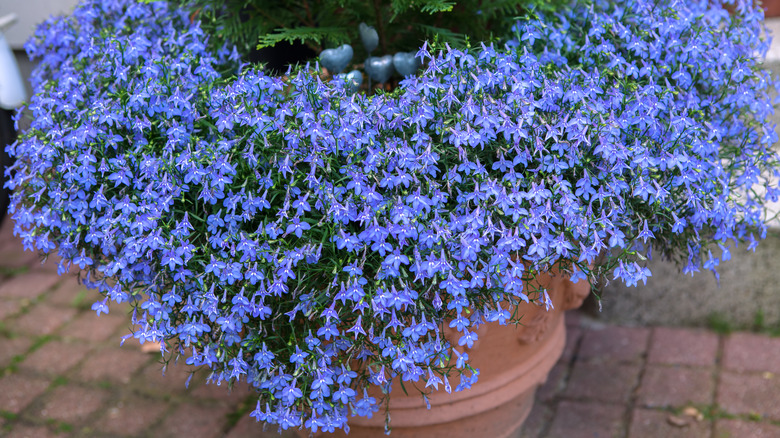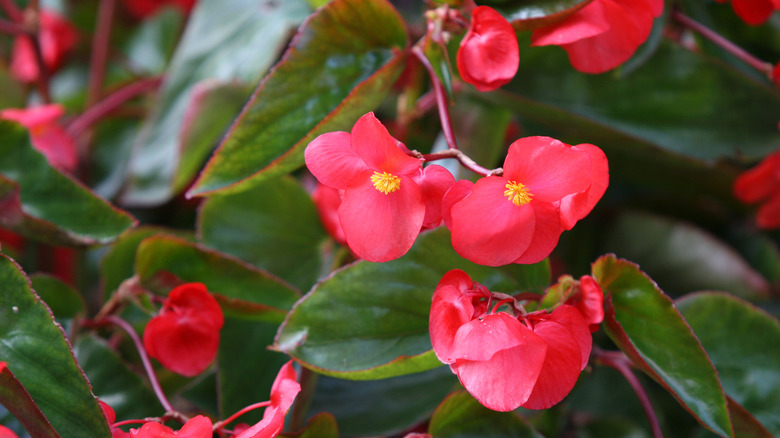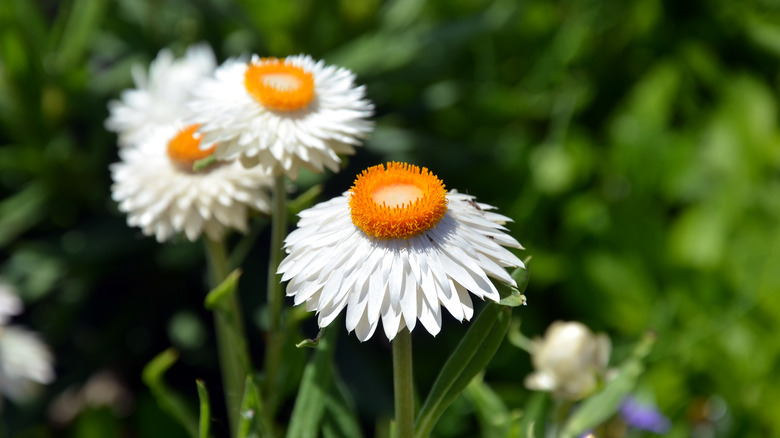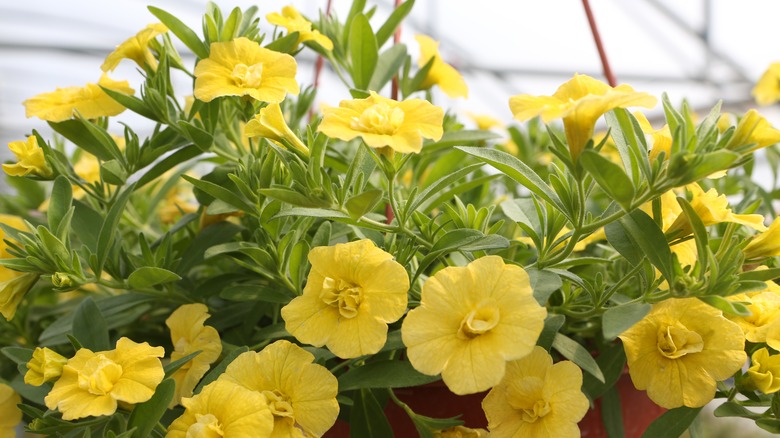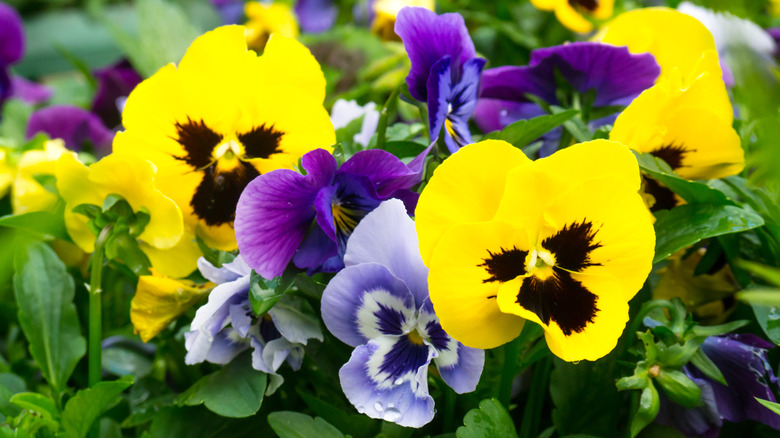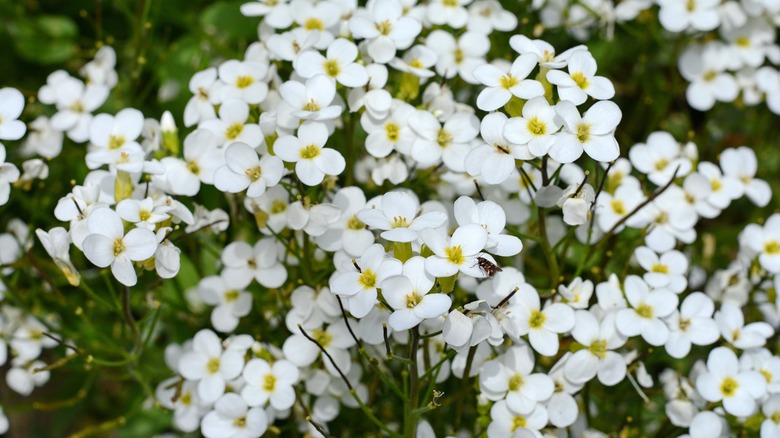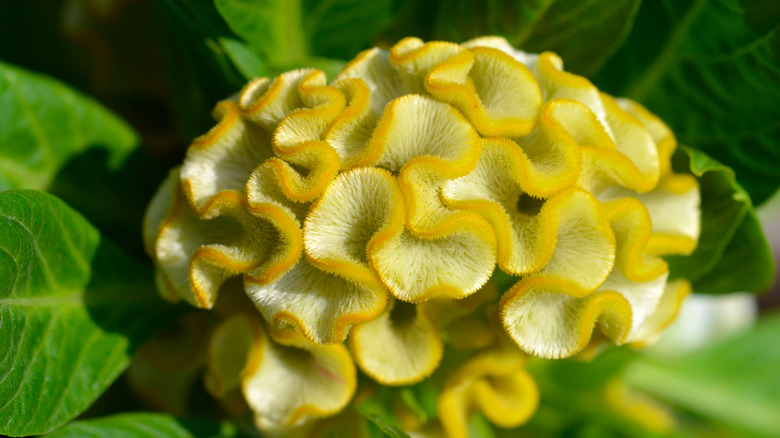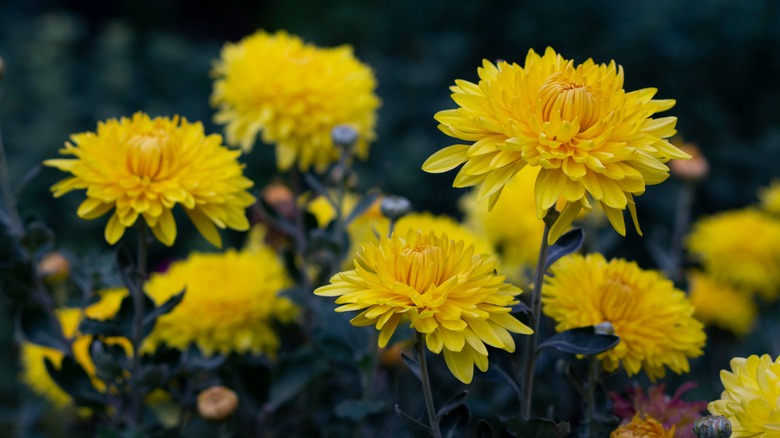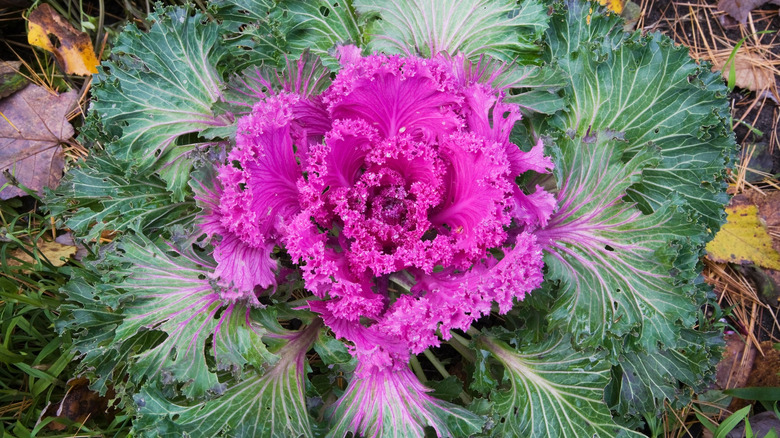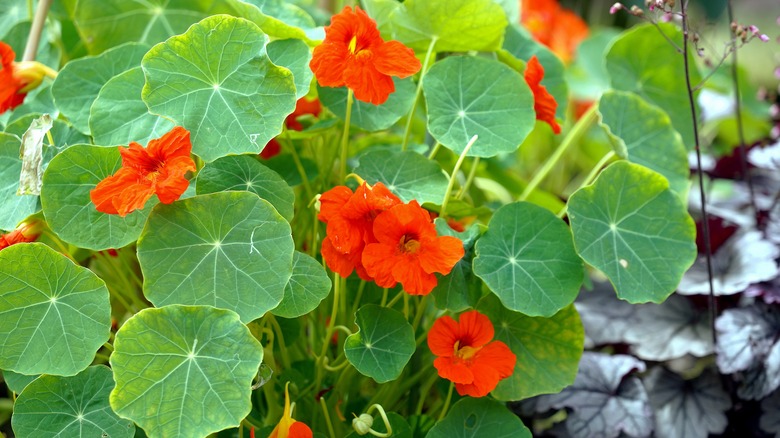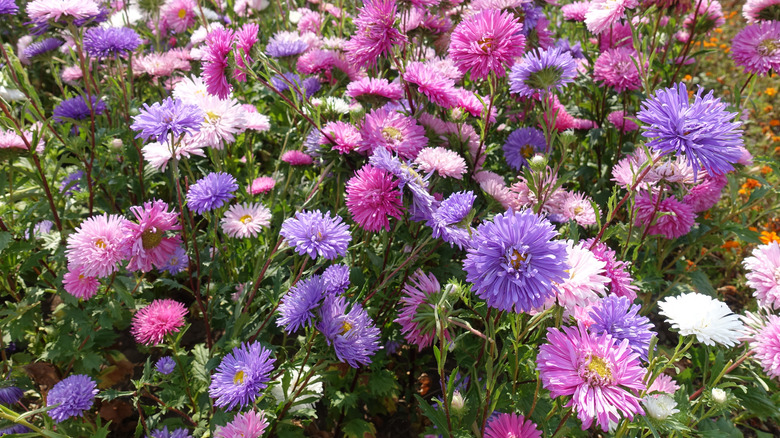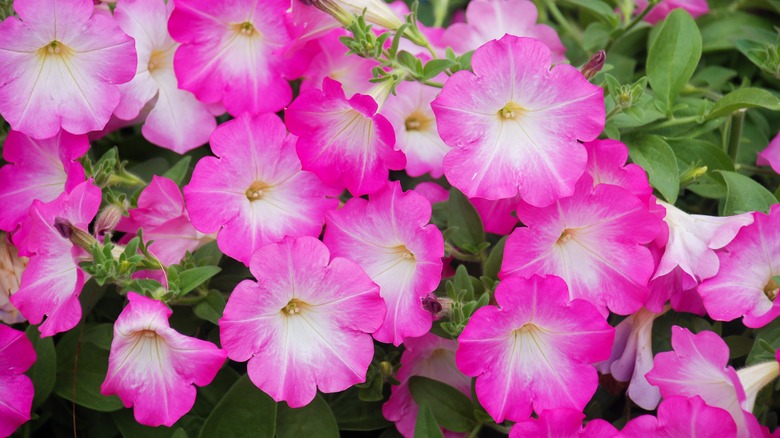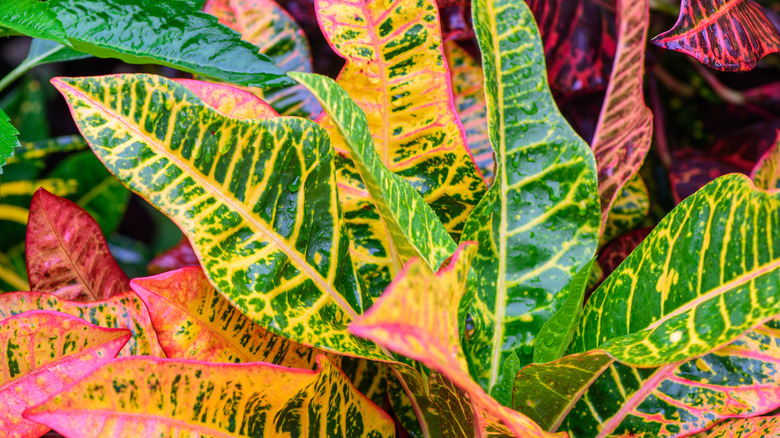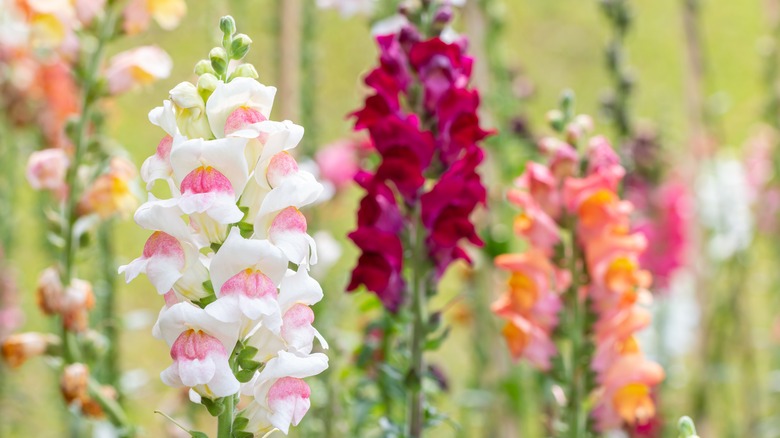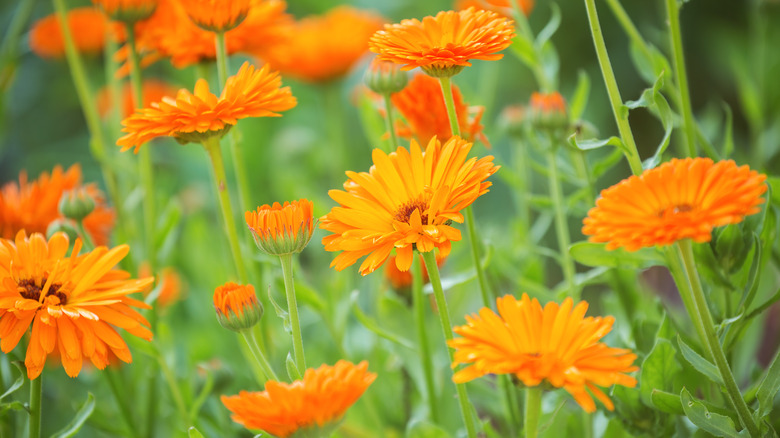15 Annuals You Should Plant For A Colorful Autumn
Designing the perfect, bold, and colorful autumn garden can be daunting if you are unfamiliar with the bloom season or the USDA growing zone of your favorite flowers and foliage-filled plants. If you live in a colder state, you know the options for plants that last into the fall are limited. Annuals are usually your best bet. Typically, they grow quickly and last until the first frost. As Penn State Extension mentions, some of them even reseed, so you don't have to worry about replacing them in the spring. These flowers, which often look great from spring to fall, help you create an amazingly low-maintenance garden that will keep your landscape looking happy until October or November, depending on where you live.
Many fall flowers and foliage will make a statement in your autumn garden, such as cockscomb and snapdragons. If you're looking for something with color to add between your fall-blooming perennials or color-changing bushes, you can try something like ornamental kale and sweet-alyssum. Our collection of annuals will get you started on the right path toward a cheery fall garden design to enjoy until frost.
1. Lobelia
Lobelia (Lobelia erinus) or edging lobelia is a long-blooming annual or tender perennial known for its large blue to violet flowers. According to Missouri Botanical Garden, this herbaceous plant, native to South Africa, is best used in hanging baskets and window boxes or for bedding in a butterfly garden.
Bloom Season: Spring to fall
USDA Growing Zone: 10 to 11
Growing Conditions: Full sun to part shade
Soil Type: Rich and well-draining
Size: 6 to 9 inches tall and wide
2. Begonias
Begonias' (Begonia spp.) bloom season, cold tolerance, and size vary greatly from species to species. With almost any of them, however, you can make your garden colorful for autumn. The best cultivar for you will depend on where you live, but hybrid cultivars such as the 'Dragon Wing' series (Begonia x hybrida 'Bepared') will continuously flower all season, as per the Clemson University Cooperative Extension Service.
Bloom Season: Spring to fall
USDA Growing Zone: 7 to 11, depending on the cultivar
Growing Conditions: Partial shade to full sun
Soil Type: Organic, moist, and well-draining
Size: Between 8 to 24 inches tall
3. Strawflowers
Strawflowers (Xerochrysum bracteatum) are an easy-to-grow species of flowers that get their name from their colorful, papery bracts. Most of these flowers look similar to daisies as they feature a central disk, typically yellow and symmetrical bracts, as described by the North Carolina Extension Gardener Plant Toolbox. Like many other long-bloomers, the strawflower attracts pollinators, grasshoppers, hoverflies, and beetles.
Bloom Season: Summer to fall
USDA Growing Zone: 8 to 10
Growing Conditions: Full sun to partial shade
Soil Type: Well-draining loam
Size: 1 to 5 feet tall and 6 to 18 inches wide
4. Calibrachoa
Calibrachoa (Calibrachoa spp.), also known as million bells, is a popular plant used in hanging baskets and window boxes. It is a prolific bloomer that holds its bright color all season until the first frost. As mentioned by the University of Minnesota Extension, this blooming annual can show off a gorgeous display of white, violet, red, blue, pink, or yellow flowers.
Bloom Season: Spring to fall
USDA Growing Zone: 9 to 11
Growing Conditions: Full sun
Soil Type: Organic, acidic, and well-draining
Size: Up to 1 foot high and 2 feet wide
5. Pansy
Pansies (Viola tricolor var. hortensis) are a somewhat low-growing flower with versatile use in the garden. As explained by The Royal Horticultural Society, some settings you may see this plant include rock gardens, garden edging, coastal gardens, and courtyard gardens. People love this plant for its long blooming period and ability to thrive in various growing conditions.
Bloom Season: Spring to fall
USDA Growing Zone: 2 to 9
Growing Conditions: Full sun to partial shade
Soil Type: Evenly moist and well-draining
Size: 4 to 20 inches tall
6. Sweet alyssum
Sweet alyssum (Lobularia maritima) is perfect for a fragrant fall garden. This flower, which blooms with wonderful white, lavender, or pink blossoms, is a mat-forming annual that can reseed itself, so you won't have to replant it every year, says the University of Wisconsin-Madison Division of Extension.
Bloom Season: Spring to fall
USDA Growing Zone: 5 to 9
Growing Conditions: Full sun to partial shade
Soil Type: Well-draining and moderately moist
Size: 3 to 9 inches tall
7. Cockscomb
The unusual flower, cockscomb (Celosia cristata), is recognized for its rippled petals that emerge in the summer and fall. This plant, as warned by Cornell University, can be challenging to grow due to its specific growing requirements. However, its warm-toned blooms are well worth all the work that goes into caring for these beautiful flowers.
Bloom Season: Summer and fall
USDA Growing Zone: 2 to 11
Growing Conditions: Full sun to partial shade
Soil Type: Fertile and well-draining
Size: Up to 3 feet tall and 1 foot wide
8. Chrysanthemum
Mums (Chrysanthemums spp.) are a summer and autumn staple in the garden. These bold, tall, and colorful bloomers are grown all over the United States as annuals, and they are pretty simple to care for. With some well-draining soil and plenty of sunlight, according to Utah State University Extension, you can enjoy mums until it becomes too cold outside for them to grow.
Bloom Season: Summer to fall
USDA Growing Zone: 5 to 9
Growing Conditions: Full sun to partial shade
Soil Type: Evenly moist and well-draining
Size: Up to 3 feet tall and wide
9. Ornamental kale
Ornamental kale (Brassica oleracea var. acephala) is often grown for leafy, visual interest in the garden, among other fall annuals. This species has thick, waxy leaves that can be purple, pink, green, white, or red. Each leaf may be as tall as 1 foot high, forming rosettes that look like large flowers, per the North Carolina Extension Gardener Plant Toolbox.
Bloom Season: Summer to fall
USDA Growing Zone: 2 to 11
Growing Conditions: Full sun
Soil Type: Rich, evenly moist, and well-draining
Size: 8 to 14 inches tall and 12 to 18 inches wide
10. Nasturtium
The low-maintenance annual, nasturtium (Tropaeolum spp.), is a warm-weather plant with rounded green leaves and tubular flowers that may be yellow, red, or orange. Multiple different nasturtium cultivars have different growth habits, and some dwarf varieties sprawl across the garden bed while other climbing types will scale trellises and fences, notes Missouri Botanical Garden.
Bloom Season: Summer to fall
USDA Growing Zone: 2 to 11
Growing Conditions: Full sun
Soil Type: Well-draining
Size: 1 to 10 feet tall and 1 to 3 feet wide
11. China aster
China asters (Callistephus chinensis) are bushy annual plants that produce yellow, white, pink, red, or purple flowers on upright stems, says The Royal Horticultural Society. This species, also known as annual asters, can be found in single, semi-double, and double-flowering varieties. Remember, they grow best in well-drained soil with plenty of direct sunlight.
Bloom Season: Summer to fall
USDA Growing Zone: 2 to 11
Growing Conditions: Full sun
Soil Type: Evenly moist and well-draining
Size: 20 to 40 inches tall and 4 to 20 inches wide
12. Petunias
Petunias (Petunia spp.) are the perfect flower for a blooming autumn garden. These flowers are not only wonderfully fragrant, but they also come in a range of colors, and they are super easy to grow. As mentioned by the University of Minnesota Extension, you can plant petunias almost anywhere as long as the soil is well-draining and the sun directly hits them.
Bloom Season: Spring to early winter
USDA Growing Zone: 10 to 11
Growing Conditions: Full sun
Soil Type: Well-draining and fertile, light sandy soil
Size: 6 to 15 inches tall, depending on the cultivar
13. Croton
Croton plants (Codiaeum variegatum) are known for their colorful, variegated leaves that add some drama to any garden. This broadleaf evergreen requires hot temperatures to survive year-round, so they are often treated as annuals or grown indoors in colder climates, explains Missouri Botanical Garden. When growing croton plants outdoors, be sure to provide them with lots of sunlight and reduced watering in the fall.
Bloom Season: Year-round
USDA Growing Zone: 11 to 12
Growing Conditions: Partial shade
Soil Type: Humusy and well-draining
Size: 2 to 6 feet tall and wide
14. Snapdragon
Snapdragons (Antirrhinum majus) are tall-growing, flowering plants that reach up to 5 feet tall. They grow fast and flower until it becomes too cold outdoors. In warmer climates, higher than USDA growing zone 7, snapdragons can bloom into the winter, as told by the University of Florida.
Bloom Season: Spring to fall
USDA Growing Zone: 2 to 11
Growing Conditions: Full sun
Soil Type: Evenly moist and well-draining
Size: 6 inches to 3 feet tall, depending on the cultivar
15. Marigold
Marigold (Calendula officinalis) or Calendula is a common garden flower well-known for its bright yellow-orange blooms that last from spring to fall. The flowers of these plants are edible, and they may be used to add color and peppery flavor to salads and soups. In some parts of the world, the flower is also used to make yellow dye, as stated by North Carolina Extension Gardener Plant Toolbox.
Bloom Season: Spring to fall
USDA Growing Zone: 2 to 11
Growing Conditions: Full sun to partial shade
Soil Type: Moist and well-draining
Size: 1 to 2 feet tall and wide
